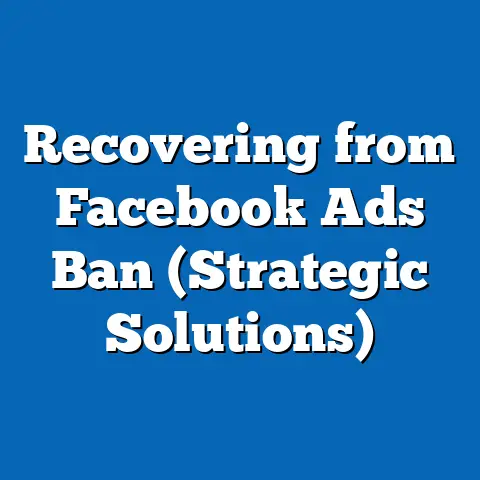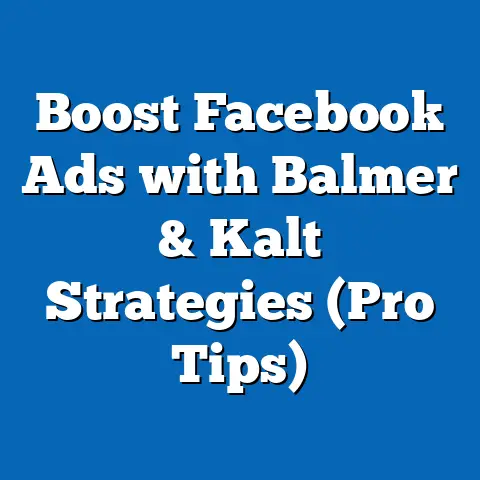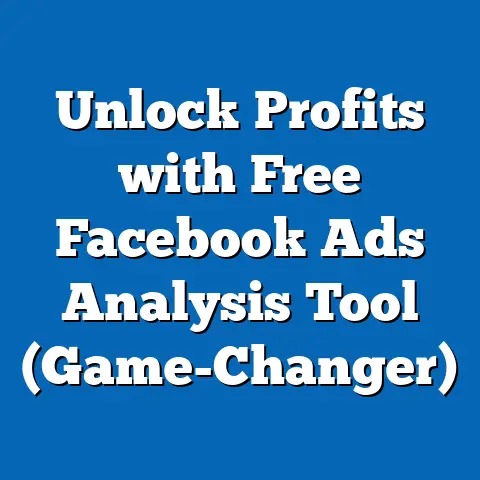Mastering CTR in Facebook Ads (Proven Calculation Strategies)
Facebook advertising can feel like navigating a complex maze. I remember when I first started, I felt overwhelmed by all the metrics and strategies. One metric, however, quickly rose to the top as a critical indicator of success: Click-Through Rate (CTR). Mastering CTR isn’t just about getting more clicks; it’s about unlocking the true potential of your Facebook ad campaigns. A higher CTR translates to increased website traffic, greater brand visibility, and, most importantly, higher conversion rates. Think of it as a signal to Facebook that your ads are relevant and engaging, leading to better placement and lower costs.
Did you know that the average CTR for Facebook ads across all industries is around 0.9%? However, the top 25% of advertisers achieve CTRs of 1.6% or higher. This gap shows the immense potential for improvement. In this article, I’ll share proven calculation strategies that I’ve personally used to boost CTR and achieve significant results for my clients. Let’s dive in and transform your Facebook ad performance!
Section 1: Understanding CTR in Facebook Ads
Let’s start with the fundamentals. Click-Through Rate (CTR) is the percentage of people who see your ad (impressions) and then click on it. In simpler terms, it measures how many people find your ad compelling enough to take action. It’s a crucial metric because it tells you how well your ad resonates with your target audience.
The CTR Formula and What It Means
The formula for calculating CTR is straightforward:
(Clicks / Impressions) x 100 = CTR (%)
For example, if your ad receives 1,000 impressions and 20 clicks, your CTR would be:
(20 / 1,000) x 100 = 2%
A 2% CTR means that 2 out of every 100 people who saw your ad clicked on it. This percentage is a direct reflection of your ad’s relevance, appeal, and targeting accuracy.
CTR as a Measure of Ad Effectiveness
CTR is more than just a number; it’s a diagnostic tool. It helps you understand:
- Relevance: Does your ad content align with the interests and needs of your target audience?
- Appeal: Is your ad visually appealing and engaging?
- Call to Action: Is your call to action clear and compelling?
- Targeting: Are you showing your ad to the right people?
By monitoring and analyzing your CTR, you can identify areas for improvement and optimize your campaigns for better performance.
Key Takeaway: CTR is a critical metric that reflects the relevance and effectiveness of your Facebook ads. Understanding its calculation and significance is the first step towards mastering your ad performance.
Section 2: The Impact of CTR on Advertising Success
A high CTR isn’t just a vanity metric; it has a tangible impact on your advertising success. It influences everything from your ad costs to your overall campaign performance.
CTR and the Facebook Ad Auction
Facebook uses an ad auction system to determine which ads to show to users. A high CTR signals to Facebook that your ad is relevant and engaging, which can lead to:
- Lower Cost-Per-Click (CPC): Facebook rewards ads with high engagement by lowering the cost you pay for each click.
- Improved Ad Placement: Ads with higher CTRs are more likely to be shown in premium placements, increasing their visibility and reach.
I’ve seen this firsthand. In one campaign, I focused on improving the ad copy and visuals, which resulted in a significant increase in CTR. As a result, our CPC decreased by 30%, and we were able to reach a larger audience with the same budget.
CTR and Quality Score
While Facebook doesn’t explicitly use a “Quality Score” like Google Ads, the concept is similar. Facebook’s algorithm assesses the overall quality and relevance of your ad based on factors like:
- CTR: A high CTR indicates that your ad is relevant and engaging.
- Relevance Score: This metric measures how well your ad matches the interests of your target audience.
- Landing Page Experience: Facebook considers the quality and relevance of your landing page.
Ads with higher engagement and relevance scores are rewarded with better placement and lower costs.
Real-World Examples of CTR Impact
Consider these scenarios:
- Scenario 1: Two ads are targeting the same audience with the same budget. Ad A has a CTR of 0.5%, while Ad B has a CTR of 2%. Ad B will likely receive more clicks, lower CPC, and better overall performance.
- Scenario 2: A business improves its ad copy and visuals, resulting in a 50% increase in CTR. This improvement leads to a significant reduction in CPC and an increase in website traffic and conversions.
These examples demonstrate the power of CTR in driving advertising success.
Key Takeaway: A high CTR can significantly impact your advertising costs, ad placement, and overall campaign performance. By focusing on improving your CTR, you can unlock better results and maximize your ROI.
Section 3: Proven Calculation Strategies to Master CTR
Now, let’s get into the practical strategies you can use to master CTR in your Facebook ad campaigns. These strategies are based on my own experience and proven best practices.
Subsection 3.1: Analyzing Ad Performance Metrics
Analyzing your ad performance metrics is crucial for understanding what’s working and what’s not. While CTR is important, it’s essential to consider other metrics as well, such as:
- Cost-Per-Click (CPC): How much are you paying for each click?
- Conversion Rate: What percentage of clicks are resulting in conversions (e.g., sales, leads)?
- Return on Ad Spend (ROAS): How much revenue are you generating for every dollar you spend on ads?
By analyzing these metrics in conjunction with CTR, you can gain a holistic view of your ad performance and identify areas for optimization.
Using Facebook Ads Manager to Track Metrics
Facebook Ads Manager provides a wealth of data and insights. Here’s how to use it effectively:
- Customize Your Columns: Add the metrics that are most important to you, such as CTR, CPC, Conversion Rate, and ROAS.
- Segment Your Data: Analyze your data by campaign, ad set, and ad to identify top-performing and underperforming elements.
- Use the Reporting Feature: Create custom reports to track your progress over time and identify trends.
I often create custom dashboards in Ads Manager to monitor key metrics at a glance. This allows me to quickly identify any issues and make data-driven decisions.
Subsection 3.2: A/B Testing for Optimal CTR
A/B testing, also known as split testing, is the process of comparing two versions of an ad to see which one performs better. This is a powerful technique for optimizing your CTR.
Setting Up A/B Tests
Here’s how to set up A/B tests in Facebook Ads Manager:
- Create a New Campaign or Ad Set: Choose the “A/B Test” objective.
- Define Your Variables: Select the elements you want to test, such as ad creative, headline, or target audience.
- Create Two Versions: Create two versions of your ad, each with a different variation of the element you’re testing.
- Set Your Budget and Schedule: Allocate a budget and schedule for your A/B test.
- Analyze the Results: After the test has run for a sufficient period, analyze the results to see which version performed better.
Interpreting Results and Implementing Findings
When analyzing your A/B test results, look for statistically significant differences in CTR. If one version has a significantly higher CTR, it’s likely the better performing ad.
Implement your findings by:
- Pausing the Underperforming Ad: Stop running the ad with the lower CTR.
- Scaling the Winning Ad: Increase the budget for the ad with the higher CTR.
- Iterating and Testing Further: Use the insights from your A/B test to create new variations and continue testing.
I once ran an A/B test on two different headlines for a client’s ad. The winning headline increased CTR by 40%, resulting in a significant boost in website traffic and conversions.
Subsection 3.3: Target Audience Segmentation
Targeting the right audience is crucial for achieving a high CTR. The more relevant your ad is to the user, the more likely they are to click on it.
Using Facebook’s Audience Insights and Segmentation Tools
Facebook provides a range of targeting options, including:
- Demographics: Target users based on age, gender, education, and other demographic factors.
- Interests: Target users based on their interests and hobbies.
- Behaviors: Target users based on their online behavior, such as purchase history and website visits.
- Custom Audiences: Create custom audiences based on your own data, such as email lists and website visitors.
- Lookalike Audiences: Create lookalike audiences based on your existing customers to reach new users with similar characteristics.
By using these targeting options effectively, you can tailor your ads to specific demographics and interests, increasing their relevance and CTR.
Tailoring Ads to Specific Demographics
I often create different ad variations for different demographic groups. For example, if I’m advertising a product that appeals to both men and women, I’ll create separate ads with different visuals and messaging to resonate with each group.
Subsection 3.4: Crafting Compelling Ad Copy and Visuals
Your ad copy and visuals are the first things users see, so they need to be compelling enough to grab their attention and encourage them to click.
Writing Compelling Ad Copy
Here are some tips for writing compelling ad copy:
- Highlight the Benefits: Focus on the benefits of your product or service, rather than just the features.
- Use Strong Calls to Action (CTAs): Tell users exactly what you want them to do, such as “Shop Now,” “Learn More,” or “Get Started.”
- Create a Sense of Urgency: Use words like “Limited Time Offer” or “Sale Ends Soon” to create a sense of urgency.
- Keep it Concise: Get to the point quickly and avoid unnecessary jargon.
Using High-Quality Visuals
Your visuals should be:
- Eye-Catching: Use bright colors, engaging images, or videos.
- Relevant: Make sure your visuals are relevant to your ad copy and target audience.
- High-Quality: Use high-resolution images and videos that look professional.
I’ve found that using user-generated content (UGC) in ads can be incredibly effective. UGC feels more authentic and relatable, which can lead to higher engagement and CTR.
Key Takeaway: Mastering CTR requires a combination of data analysis, A/B testing, precise targeting, and compelling ad creative. By implementing these strategies, you can significantly improve your ad performance and achieve better results.
Section 4: Advanced Strategies for Sustaining High CTR
Once you’ve achieved a good CTR, it’s important to sustain it over time. Here are some advanced strategies to help you do just that.
Retargeting Campaigns
Retargeting campaigns involve showing ads to users who have already interacted with your business in some way, such as visiting your website or engaging with your social media content. These users are more likely to be interested in your products or services, which can lead to higher CTRs.
Creating Retargeting Audiences
You can create retargeting audiences in Facebook Ads Manager based on:
- Website Visitors: Target users who have visited specific pages on your website.
- Engagement: Target users who have engaged with your Facebook or Instagram content.
- Customer Lists: Upload your customer list to target existing customers.
Personalizing Ads for Retargeting Audiences
Personalize your ads for retargeting audiences by:
- Highlighting Products They Viewed: Show users ads for the specific products they viewed on your website.
- Offering Exclusive Discounts: Offer retargeting audiences exclusive discounts to incentivize them to make a purchase.
- Addressing Objections: Address any common objections or concerns that users might have.
Dynamic Ads and Personalized Content
Dynamic ads automatically show users products or services that are relevant to their interests and behavior. This personalization can lead to higher CTRs and conversion rates.
Setting Up Dynamic Ads
To set up dynamic ads, you’ll need to:
- Create a Product Catalog: Upload your product catalog to Facebook.
- Set Up a Pixel: Install the Facebook pixel on your website to track user behavior.
- Create a Dynamic Ad Campaign: Choose the “Catalog Sales” objective and create a dynamic ad campaign.
Personalizing Content
Personalize your ad content by:
- Using Dynamic Product Ads: Show users ads for the specific products they viewed on your website.
- Tailoring Messaging: Tailor your messaging to specific user segments based on their interests and behavior.
Seasonal Trends and Timely Promotions
Take advantage of seasonal trends and timely promotions to drive clicks. For example, you could run a special promotion for Valentine’s Day or offer discounts during the holiday season.
Aligning Ads with Seasonal Events
Align your ads with seasonal events by:
- Using Relevant Visuals: Use visuals that are relevant to the season or holiday.
- Tailoring Messaging: Tailor your messaging to the season or holiday.
- Offering Seasonal Promotions: Offer special promotions or discounts for the season or holiday.
Key Takeaway: Sustaining a high CTR requires ongoing optimization and the use of advanced strategies like retargeting, dynamic ads, and seasonal promotions. By staying proactive and adapting to changing trends, you can maintain a competitive edge.
Conclusion
Mastering CTR in Facebook ads is an ongoing process that requires a combination of data analysis, strategic thinking, and creative execution. By understanding the fundamentals of CTR, analyzing your ad performance metrics, conducting A/B tests, targeting the right audience, and crafting compelling ad creative, you can significantly improve your ad performance and achieve better results.
Remember, a high CTR is not just a vanity metric; it’s a critical indicator of your ad’s relevance, appeal, and targeting accuracy. By focusing on improving your CTR, you can unlock better ad placement, lower costs, and ultimately, higher conversion rates.
I encourage you to implement the proven calculation strategies discussed in this article in your own Facebook ad campaigns. Take the time to analyze your data, conduct A/B tests, and experiment with different targeting options and ad creative. With consistent effort and a data-driven approach, you can achieve a robust CTR and unlock the true potential of your Facebook advertising.
Now, go out there and start optimizing your Facebook ads for improved CTR! I’m confident that with the right strategies and a commitment to continuous improvement, you can achieve significant results and drive your business forward.






